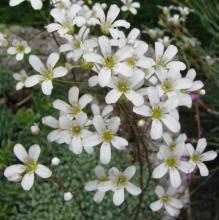
Description and general information
This species is one of the Ligulatae group of saxifrages, commonly known as the encrusted or silver saxifrages. It has a very restricted natural range being found in the Maritime Alps near the towns on Tende, Val de Cairos and Brigue, France and in southeast Genoa, Italy.
Plants produce relatively small rosettes of stiff, narrow, silvery leaves with a distinct spoon-shaped tip. Flower stems arise 10-25 cm and produce a loose spray of up to 60 white flowers which occasionally may be spotted red. This species is among the last of the silver saxes to bloom.
Cultivation
Cultivation is generally easy. Full morning sun is preferred with some shade from the hottest part of the day. In the wild, these saxes often grow on east to north-facing cliffs. While this species naturally grow on limestone they are not obligate to it.
The small stature of this species makes them ideal candidates for troughs, tufa gardens, crevice gardens and pot culture.
Bloom period
April in warmer climates but into July in colder areas.
Propagation
This species may be propagated from rosette cuttings, division or seed.
Seed
According to the Ontario Rock Garden Society seed germination guide Sow @ 20C for 6 weeks, then place @ 4C for 6 weeks, then slowly raise temperature to 10C for 6 weeks. If there is no germination, repeat the cycle.
Having noting this, I have successfully germinated seed by surface-sowing the seed, covering them in fine grit, gently water them then placing the pot in a root cellar (2-5 C) for 8 weeks. They were then subjected to 10-15 C where they germinated within 3-4 weeks. Fresh seed certainly germinates the best. be forwarned. The silver saxes will freely interbreed when given the chance so depending on the seed source, you may end up with a hybrid.
Division
Larger clumps may be divided in early spring or after they have finished flowering.
Cuttings
Individual rosettes may be broken off in mid-summer and rooted in a shaded sand bed.
References
1 Silver Saxifrages by Beryl Bland
